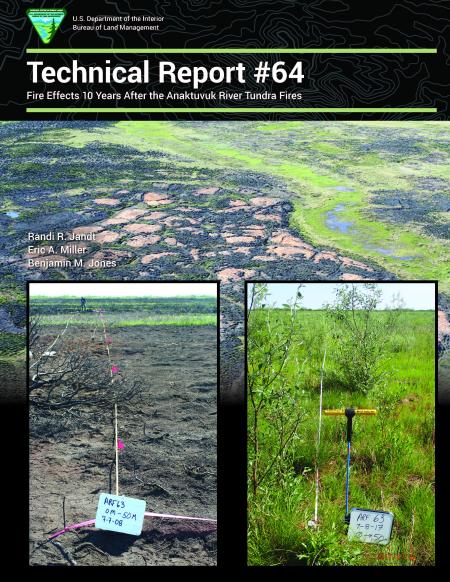Fire Effects 10 Years After the Anaktuvuk River Tundra Fires

Data on fire effects and vegetation recovery are important for assessing the impacts of increasing temperatures and lightning on tundra fire regimes and the implications of increased fire in the Arctic for wildlife and ecosystem processes. This report summarizes information collected by the Bureau of Land Management (BLM), U.S. Geological Survey, and University of Alaska Fairbanks, as well as other cooperators between 2008 and 2017 on the effects of 2007 tundra fires on Alaska’s North Slope.
We monitored vegetation, soil properties, thaw depths, and collected repeat photos on a set of 23 burned transects and 11 unburned reference transects periodically (N=5 visits) between 2008 and 2017 on the Anaktuvuk River and adjacent Kuparuk River fires. Post-fire regrowth of vegetation was rapid for some species such as cottongrass (Eriophorum vaginatum) and expansive carpets of fire mosses and liverworts that developed after the first year on severely burned areas. Relative to unburned tussocks, tussocks that experienced burning inside the fire perimeter continue to grow and flower more vigorously after ten years, suggesting a continued increase of soil nutrients, competitional release, or a response to warming at root-level. Other species were declining (Sphagnum mosses) or virtually absent (lichens) in the burned areas. Post-fire accumulation of organic material over the first decade was about 5 cm of moss and plant litter. This layer of recently cast fine fuel along with sedge leaf litter carried two small lightning-ignited reburns in early-2017. Shrubs re-established more slowly than herbaceous species: by the tenth year post-fire, cover of deciduous shrubs on burned transects equaled reference transects but that of ericaceous subshrubs still lagged. Species of tall willow appeared to be responding by increases in stature and colonization of thermokarst-affected terrain. Other studies suggest that tundra north of the Brooks Range is responding to climate change with widespread expansion of and dominance by tall shrubs in the absence of fire. Our observations from this burn, as well as at several other older burns, suggest that fire greatly accelerates this succession. Shifts in community species composition seem likely for many years to come in the burn area.
We documented burn severity and effects on permafrost, thaw depth, and surface topography. Field-validated burn severity indices from satellite remote sensing showed that 80% of the fire burned with moderate-to-high severity (Kolden and Rogan, 2013). Thaw depth, pH, temperature, residual organic duff depth, and other soil characteristics were recorded. Burned transects, especially those underlain by yedoma soils (ice-rich Pleistocene permafrost deposits), exhibited substantial subsidence as a result of thermokarst. At some transects, ground-ice melt created ice wedge troughs deeper than 1 m in the first ten years following the burn. Even low severity burn areas experienced notable ground subsidence as evidenced by degrading ice wedges. Mean annual ground temperature at 1 m depth has warmed 1.5°C relative to unburned tundra over the ten years post-burn.
